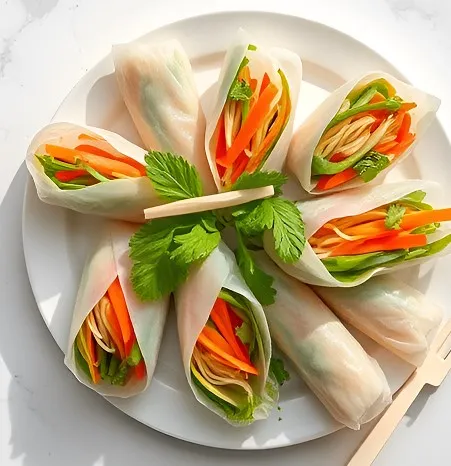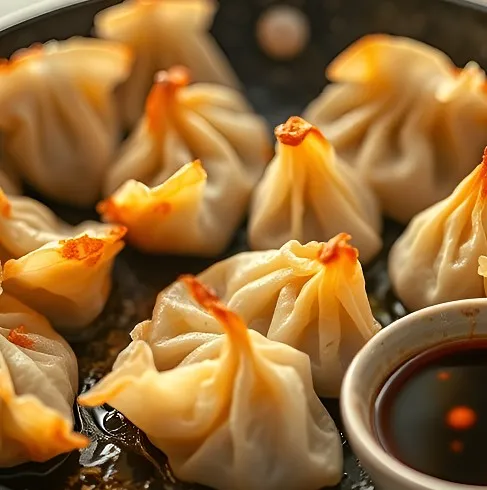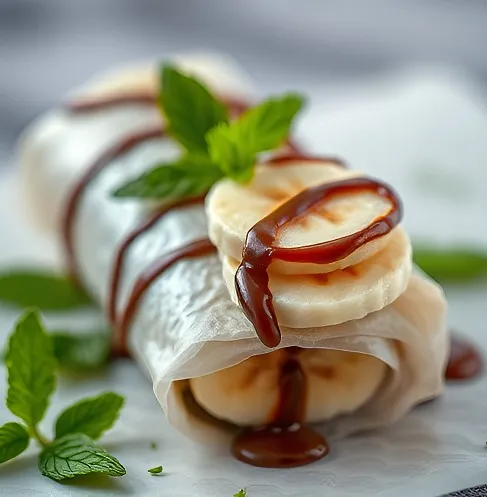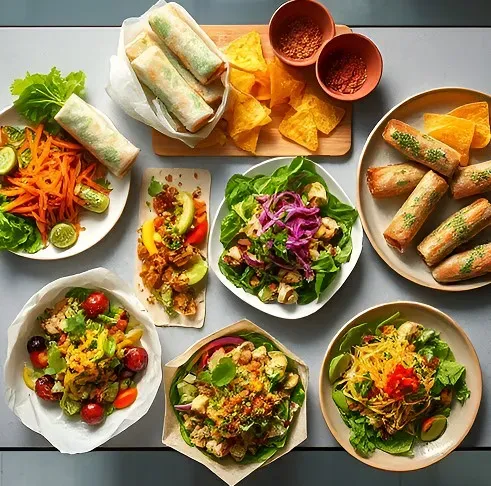Rice paper might seem unassuming at first glance—a thin, almost translucent sheet you spot in the international aisle—but trust me, this little culinary marvel holds secrets that will transform your kitchen adventures. From light and refreshing fresh spring rolls to unconventional fried dumplings or even crispy chips, is your ticket to creative, gluten-free cooking that never fails to impress. Join me on a deep dive into the world of rice paper, where we’ll explore its many uses, share expert tips, and reveal innovative recipes that will make you a bona fide wizard.
Table of Contents
What Exactly Is Rice Paper?
Let’s clear up a common misconception right away: rice paper isn’t paper at all. Despite the name, it’s actually the product of rice flour, water, and a pinch of salt, sometimes enriched with a bit of tapioca flour to lend extra stretch. Traditionally, these ingredients are mixed and processed into thin sheets that are then dried until they become hard and brittle. In many Southeast Asian cuisines, these sheets are essential for preparing fresh appetizers and light meals.
What makes rice paper so intriguing is its remarkable transformation. A quick soak in warm water is all it takes to shift from its hardened state to a pliable canvas, ready to enclose vibrant fillings. The simplicity of its ingredients accounts for its neutral flavor profile, allowing the colors, textures, and flavors of your ingredients—be it crunchy vegetables, tender seafood, or aromatic herbs—to take center stage.
The Cultural and Culinary Backdrop
has been a staple in Southeast Asian kitchens for generations. Its roots spread across Vietnam, Thailand, and other neighboring regions, where its use is synonymous with health and culinary finesse. Over time, chefs and home cooks alike have discovered that rice paper’s lightness and gluten-free nature not only make it an excellent wrapper but also a versatile ingredient from sweet treats to savory snacks. As we explore these innovative ideas, you’ll see firsthand why rice paper continues to inspire culinary creativity around the globe.
Light, Airy, and Gluten-Free: A Chef’s Dream
There’s a reason why foodies and health-conscious cooks are raving about rice paper. Its delicate texture and neutral taste allow the ingredients inside to shine. Whether you’re aiming for a light lunch or a sophisticated appetizer, rice paper offers a crisp bite when fresh and a delightful crunch when fried. This innovative ingredient is especially attractive for anyone on gluten-free diets, giving you endless freedom to experiment without compromising flavor or texture.
From Tradition to Modern Innovation
While rice paper has long been known for its role in preparing spring rolls, its potential goes far beyond this traditional dish. Modern cooks are finding inventive ways to use rice paper to create everything from deconstructed salads to elegant appetizers. Its inherent simplicity and adaptability mean you can substitute it for other wrappers, allowing you to reinvent classic recipes and forge entirely new ones. This blank canvas approach is what makes rice paper a beloved secret in kitchens worldwide.
Beyond Spring Rolls: Exploring Innovative Creations with Rice Paper
Rethinking the Role of a Wrapper
Most people first encounter rice paper as the outer layer of a spring roll. Yet, once you master the technique of handling these delicate sheets, a whole world of culinary possibilities unfolds. Think of rice paper as your invitation to reimagine everything from dumplings to tacos. Once softened, its pliable form means you can roll, fold, or even layer it to create distinct textures and flavors in every bite.
For instance, consider the idea of rice paper dumplings—a fun and inventive twist on classic dumpling recipes. Instead of using traditional dough, simply soften rice paper, cut it into manageable pieces, fill it with your favorite mix of ground meat or finely chopped vegetables, and then steam, pan-fry, or deep-fry the dumplings until they’re perfectly chewy and flavorful.
Creating New Snack Sensations
Another unexpected application of rice paper is turning it into chips. Yes, you heard that right! By lightly oiling a softened sheet, dusting it with your favorite seasonings, and baking until crispy, you can whip up a batch of gluten-free chips that deliver an irresistible crunch. These rice paper chips make a fantastic alternative snack for those who crave healthy, yet tasty, munchies without compromising on texture.
Sweet Surprises with Rice Paper
Rice paper isn’t limited to the realm of savory dishes. Its neutral flavor also lends itself beautifully to desserts. Envision a delicately crispy wrap filled with warm, gooey Nutella and banana slices, or a twist on the classic mango sticky rice, where mango chunks are enclosed in a thin rice paper layer and then baked to perfection. These desserts not only offer a delightful contrast of textures but also serve as impressive conversation starters at any gathering.
Mastering the Art of Fresh Rice Paper Rolls
The Classic Fresh Spring Roll Experience
Let’s get down to one of the most iconic uses of rice paper: the fresh spring roll. Think of a fresh spring roll as a perfectly packaged bundle of flavor, texture, and color. The secret to a great spring roll starts with high-quality ingredients. Traditional fillings might include a mix of crisp lettuce, shredded carrots, fresh cucumbers, vermicelli noodles, and an aromatic blend of herbs such as mint and cilantro. For the protein, choices like succulent shrimp, tender chicken, or marinated tofu work beautifully.
To begin, prepare a shallow dish filled with warm water—just warm enough to transform your rice paper from its brittle form to a supple one. Carefully dip one sheet into the water for only a few seconds; over-soaking can make the paper too slack and prone to tearing. Lay the softened rice paper out on a clean, damp surface. Place your fillings near the center, taking care not to overload the wrapper, and then fold in the sides before rolling it up tightly.
The result is a vibrant, healthy roll that’s as pleasing to the eye as it is to the palate.

Expert Tips for Perfect Rolls
Making the perfect spring roll isn’t just about following a recipe—it’s an art. A few insider tips can help elevate your rice paper game:
- Timing Is Everything: Soak the rice paper just long enough to make it pliable. An extra second too long, and you risk ending up with a mushy wrapper.
- Keep It Dry: Be mindful of moisture. Ensure that any ingredients you add, especially vegetables, are patted dry to prevent the roll from becoming soggy.
- Practice Makes Perfect: Like any culinary skill, the more you work with rice paper, the more confident you’ll become. Don’t worry if your first few rolls aren’t museum quality—each one is a step toward mastery.
Experiment with different filling combinations. Beyond the classic shrimp or chicken, try a medley of grilled tofu with crunchy bell peppers and a drizzle of spicy peanut sauce, or perhaps a vegetarian option featuring avocado, sprouts, and tangy pickled vegetables.
Elevating Your Rice Paper Game: Fried and Baked Variations
Crispy Fried Spring Rolls
Sometimes, you might crave a textural twist—a delightful crunch to go with that burst of freshness. Transform your freshly rolled spring rolls into a crispy appetizer by deep-frying them to a golden perfection. After rolling your fillings into a neat bundle, heat up your choice of oil in a deep pan or fryer. Gently place the rolls into the hot oil, being careful not to overcrowd the pan, and fry them until each roll has an even, crispy, golden-brown exterior.
The result is a fusion of textures: the softness of the interior combined with a satisfying crispiness that elevates each bite into an experience worth savoring.

Rice Paper Dumplings: A Novel Twist
Take a leap beyond convention by trying your hand at rice paper dumplings. Instead of traditional dough, use the same technique for softening rice paper and cut the sheet into small, workable shapes—circles or squares work best. Place a tiny spoonful of your preferred filling (think a mix of minced pork, shrimp, or even finely diced vegetables) in the center before folding the paper neatly. Whether you steam, pan-fry, or deep-fry these bundles, they emerge with a delightfully chewy exterior that encapsulates bold flavors.
This approach offers a fun fusion of textures and techniques, showcasing the versatility that rice paper brings to both traditional and modern dishes.
Rice Paper Chips: A Snack That Surprises
If you’re in the mood for an unexpected snack, rice paper chips might be just what you need. Start by softening a sheet of rice as you would for a spring roll. Lay the sheet flat, brush it lightly with a neutral oil (olive oil works nicely), and sprinkle with your favorite seasonings—be it sea salt, paprika, or garlic powder. Slide the sheet into a preheated oven and bake until it puffs up and turns a crisp, delicate golden hue.
These chips are the perfect gluten-free alternative to the usual snack fare, offering both healthfulness and a crunch that rivals traditional potato chips.
Baked Rice Paper Creations
Not a fan of deep-frying? Baked rice paper recipes are your answer. You can create a variety of baked treats using rice paper as the base. For example, brush a softened sheet with olive oil, add a thin layer of toppings such as herbs, a light spread of cheese, or even tomato sauce, and then bake until the edges crisp up. The outcome is a unique, low-calorie substitute for heavier breads and crackers, ideal for a wholesome snack or appetizer.
Sweet Surprises: Transforming recipe into Desserts
Rice paper isn’t solely reserved for savory endeavors. Its almost flavorless composition makes it an exciting medium for dessert experimentation. Imagine a dessert roll where sweet fillings are wrapped in a delicate rice paper blanket and then either baked or lightly fried to achieve a delightful, crispy finish.
One creative option is to assemble a roll filled with sliced bananas and a generous drizzle of Nutella. The contrast between the warm, gooey center and the crispy exterior adds an unexpected twist to a favorite dessert. Another idea is to combine tropical flavors: think mango cubes with a sprinkle of sticky rice, rolled in a thin sheet of rice paper, and lightly baked to enhance its natural sweetness.
For those who prefer a deconstructed dessert, consider baking paper until it’s crisp, crumbling it over a bowl of vanilla ice cream or a vibrant fruit salad. The result is a sophisticated finale to your meal—a meld of textures and temperatures that spark intrigue and delight.
These dessert ideas remind us that with a little imagination,the dish can cross the boundaries of traditional culinary roles and emerge as a key player in both your savory and sweet recipe collections.

Innovating the recipe with : Tacos, Pizza, and Beyond
Rice Paper Tacos: A Gluten-Free Shell Alternative
If you’ve ever dreamed of a lighter, gluten-free taco shell, rice paper might just be your new best friend. Start by soaking a paper sheet in warm water until it softens. For added durability, layer two or three sheets together before gently folding them into a taco shape. The result is a flexible yet sturdy shell that can hold an array of fillings—from seasoned ground meat and shredded chicken to a hearty mixture of black beans and corn.
Not only does this method offer a creative twist on traditional taco preparations, but it also paves the way for healthier, lower-calorie alternatives without compromising on flavor or satisfaction.
Rice Paper Pizza: A Crisp, Unconventional Crust
Who said pizza crusts have to always be thick and doughy? Rice paper can be an intriguing alternative for those looking to experiment with a super-thin, crispy base. Start by softening a rice paper sheet and brushing it with a bit of olive oil. Spread your favorite tomato or pesto sauce on top, sprinkle an appropriate amount of cheese, and layer your preferred toppings. Pop it into the oven until the cheese melts and the edges of the rice paper transform into delightful, crunchy bites.
This rice paper pizza might offer a different experience compared to traditional pies, but it’s perfect when you’re in the mood for something light and crispy that still packs a punch of flavor.
Deconstructed Rice Paper Creations: Bowls and Salads
Sometimes, the process of rolling isn’t what your mood calls for. In such cases, consider deconstructing your spring roll ingredients into a vibrant bowl or salad. Prepare your noodle, vegetable, and protein selections as usual, then tear or slice softened rice paper into bite-sized pieces. Toss these delicate fragments with your favorite dressing or sauce. The result is a dish that maintains all the flavor and texture combinations you love from a spring roll, but in an entirely new, refreshingly unconfined form.
Essential Tips and Techniques for Working with Rice Pape
Finding the Goldilocks Zone: Perfect Water Temperature
Whether you’re making fresh rolls, crispy chips, or experimental dumplings, the key to working with rice paper lies largely in the water temperature. Water that’s too cold won’t soften the sheet properly, while water that’s too hot might render the paper overly sticky and fragile. A good rule of thumb is to use water approximately the temperature you’d use for a comfortable hand wash. This “Goldilocks” temperature helps the rice paper achieve its optimal balance—pliable and ready to work with, but still resilient enough for creative folding.
Handling with Care: Avoiding Tears and Stickiness
Delicacy is part of the charm and challenge of working with rice paper. Always work with one sheet at a time and ensure your work surface is clean and slightly damp to prevent premature sticking. If you notice sheets adhering to one another, a brief rinse under running water can gently separate them without damaging the delicate structure. Embrace the process as an art form; each unsuccessful roll is merely a stepping stone on your journey to perfect technique.
Storage and Freshness
Unopened rice paper packages are remarkably long-lived when stored in a cool, dry place, making it a pantry staple for impromptu culinary adventures. Once opened, however, it’s best to keep your remaining sheets in an airtight container or sealed bag. This ensures they remain pliable and ready for immediate use. For freshly made creations like spring rolls, if you must store them, wrap each roll individually in a lightly damp paper towel and seal in an airtight container to maintain freshness and prevent sticking.
Dipping Sauces: The Perfect Companion for Your Creations
Classic Peanut Sauce: The Unforgettable Pick-Me-Up
No rice paper creation is complete without the right dipping sauce, and peanut sauce traditionally holds that coveted spot of honor. This sauce, often a blend of peanut butter, soy sauce, rice vinegar, a touch of honey or sugar, minced garlic, and occasionally a dash of sriracha, provides the perfect creamy, savory counterbalance to the crisp freshness of the rolls. Its rich texture and nuanced flavor helps every bite resonate with warmth and familiarity.
Sweet Chili Sauce: Balancing Sweet and Heat
For those who prefer a bit of spice with a touch of sweetness, sweet chili sauce is a stellar option. Its lively combination of sugar, vinegar, and chili elevates both fresh and fried rice paper dishes. Whether you buy a pre-made bottle or whip one up with a few simple ingredients like chili garlic sauce, rice vinegar, and a hint of sugar, it’s a versatile accompaniment that never fails to add an irresistible kick.
Other Flavorful Options
Beyond these classics, experiment with sauces that bring fresh and tangy flavors to the table. Vietnamese nuoc cham—comprising fish sauce, lime juice, a pinch of sugar, and red chili slices—provides a complex, bright flavor profile ideal for seafood-based rolls. Alternatively, a simple soy and ginger dipping sauce can perfectly accent dumplings or rice paper tacos. The key is to allow the dipping sauce to enhance the natural flavors of your fillings without overwhelming them.
FAQs: Everything You Need to Know
Is it gluten-free?
Absolutely. Traditional rice paper is made solely from rice flour, water, and salt, making it a naturally gluten-free ingredient. However, it’s wise to double-check the ingredients list on any brand you purchase to be sure no additional additives have been included.
Where can I buy the paper?
Most modern grocery stores stock rice paper in the international or Asian food aisle, and specialty Asian markets typically offer a wider variety of brands and sizes. Its growing popularity means you have many options whether you’re shopping online or in a brick-and-mortar store.
Can rice paper be reused once it’s been soaked?
Unfortunately, rice paper is a one-and-done ingredient. Once it’s been softened, it can’t be reused for another roll or wrap. If you find yourself with extra softened sheets, it’s best to use them as an experimental ingredient in another dish or simply discard them.
How do I prevent rice paper rolls from sticking to my serving plate?
To maintain the integrity of your freshly made rice paper creations, lightly dampen your serving plate with water or opt for a bed of lettuce or parchment paper. This extra step ensures that the rolls remain pristine and won’t stick, allowing you to present them beautifully.
Embracing the Rice Paper Revolution
Rice paper offers a gateway to culinary innovation. Its simplicity, delicate texture, and adaptability provide an exciting alternative to conventional ingredients. With its profound influence in traditional Southeast Asian cooking and its emerging role in modern, experimental kitchens across the globe, rice paper has proven that the simplest ingredients often carry the greatest potential.
Happy cooking, and may your kitchen always be filled with bold flavors, creative experiments, and the satisfying crunch of perfectly prepared recipes!

